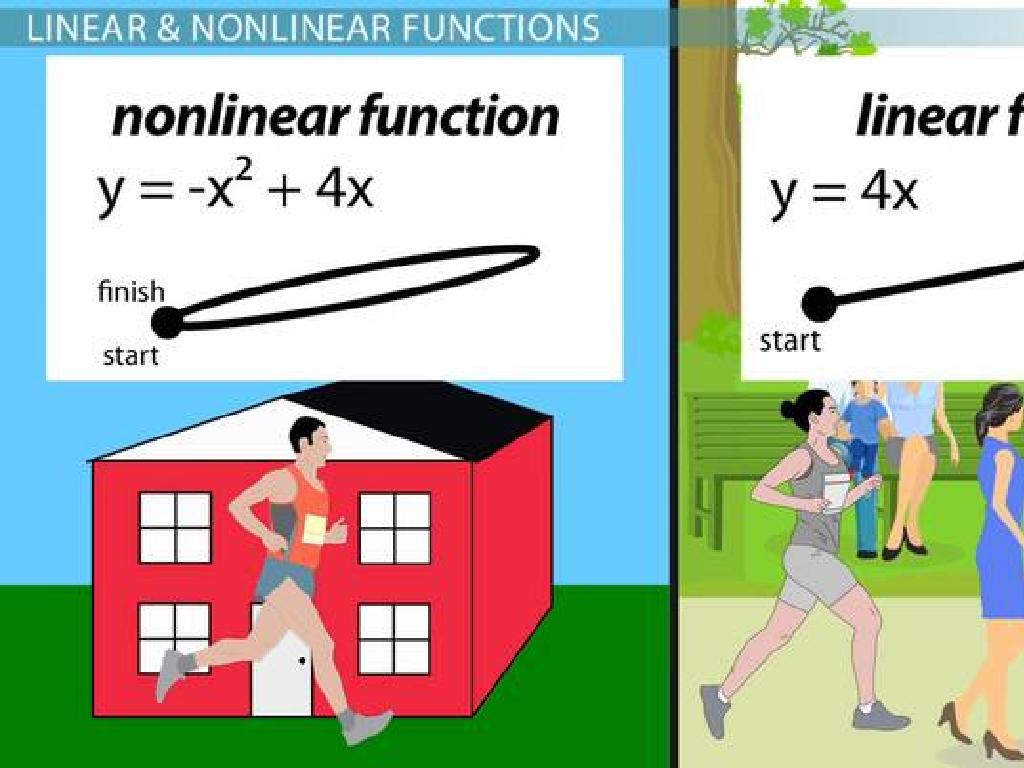Semiconductor Devices
Subject: Science
Grade: High school
Topic: Electrical Engineering
Please LOG IN to download the presentation. Access is available to registered users only.
View More Content
Introduction to Semiconductor Devices
– Basics of semiconductor devices
– Semiconductors are materials with conductivity between conductors and insulators.
– Their role in modern tech
– They’re crucial in computers, phones, and medical equipment.
– Overview of today’s lesson
– We’ll explore types, functions, and applications of semiconductors.
– Learning objectives
– Understand semiconductor concepts and their impact on technology.
|
This slide introduces the fundamental concepts of semiconductor devices, which are integral to all modern electronic circuits. Begin by explaining what semiconductors are and their unique property of variable conductivity. Highlight the omnipresence of semiconductor devices in everyday technology, emphasizing their importance in the current digital era. Provide a brief overview of the lesson, outlining the types of semiconductor devices, their functions, and real-world applications. The learning objectives should be clear: students will gain a foundational understanding of semiconductor devices and appreciate their significance in advancements in technology. Encourage students to think of electronic devices they use that might contain semiconductors.
Understanding Semiconductors
– Define semiconductor materials
– Substances with conductivity between conductors and insulators, e.g., silicon.
– Conductivity in semiconductors
– Conductivity can change with temperature, impurities, or light exposure.
– Contrast with metals and insulators
– Metals conduct easily, insulators don’t; semiconductors are in-between.
– Silicon & Germanium examples
– Common semiconductors used in electronics due to their properties.
|
This slide introduces the concept of semiconductors, which are materials with unique properties that make them fundamental to modern electronics. A semiconductor’s conductivity is not as high as a metal’s but significantly higher than that of an insulator. This property can be altered by factors such as temperature, which makes semiconductors versatile for various applications. Silicon and Germanium are two primary examples of semiconductor materials used in the industry. They form the basis of diodes, transistors, and integrated circuits. Understanding the behavior of these materials is crucial for students who wish to delve into the field of electrical engineering and electronics.
Intrinsic and Extrinsic Semiconductors
– Pure semiconductors: Intrinsic
– Intrinsic semiconductors are pure forms without impurities.
– Doping process: Extrinsic creation
– Adding specific impurities alters conductivity.
– N-type and P-type semiconductors
– N-type: extra electrons. P-type: ‘holes’ for electron movement.
– Conductivity and applications
|
This slide introduces the fundamental concepts of semiconductor physics. Intrinsic semiconductors are pure forms of semiconductors without any significant impurity atoms. Extrinsic semiconductors are created by introducing impurities into the intrinsic semiconductor in a process called doping, which increases its conductivity. There are two main types of doping: N-type, where extra electrons are added, and P-type, where there are ‘holes’ or spaces for electrons to move, effectively creating positive charge carriers. Understanding these concepts is crucial for students as they form the basis for how semiconductor devices like diodes and transistors work, which are essential components in modern electronic devices.
Understanding PN Junctions in Semiconductor Devices
– Formation of PN Junctions
– A PN junction is created when p-type and n-type semiconductor materials are joined, crucial for diode function.
– Depletion Region and Barrier Potential
– The depletion region is a non-conductive zone due to charge carrier loss, with a built-in barrier potential preventing current flow.
– Forward Bias Condition
– Forward bias reduces the barrier, allowing current to flow when the positive terminal is connected to the p-type material.
– Reverse Bias Condition
– Reverse bias increases the barrier, preventing current flow by connecting the positive terminal to the n-type material.
|
This slide introduces the concept of PN junctions, which are fundamental to the operation of many semiconductor devices such as diodes. The formation of a PN junction creates a depletion region where mobile charge carriers are absent, resulting in a barrier potential that affects current flow. In forward bias condition, this barrier is lowered, allowing current to pass through, which is the operating principle behind diodes allowing current in one direction. In reverse bias, the barrier is increased, preventing current flow. Understanding these concepts is crucial for students to grasp how electronic devices control and manipulate electrical current. Provide examples of each bias condition’s effect on current flow and encourage students to think of real-life applications of diodes, such as rectifiers in power supplies.
Understanding Diodes in Electronics
– Diode function and symbol
– A diode allows current to flow in one direction, symbolized by an arrow.
– Diode applications in circuits
– Used for power conversion, signal demodulation, and more.
– Rectification process example
– Converts alternating current (AC) to direct current (DC).
|
This slide introduces the basic concept of diodes, their function, and their symbol. A diode is a semiconductor device that permits current flow in one direction while blocking it in the opposite direction, which is crucial for various electronic applications. Highlight the importance of diodes in everyday electronic devices, such as power adapters and radios, where they serve to convert AC to DC (rectification). Use the rectification process as a concrete example to show how diodes are used in circuits to alter the type of current. Encourage students to think of other applications where diodes might be used and to visualize the flow of current in one direction as a fundamental property of diodes.
Transistors: The Building Blocks of Electronics
– Introduction to BJTs and FETs
– BJTs control current flow, FETs control electrical field
– Transistor configurations
– Common base, emitter, collector affect input/output
– Transistor as a switch
– Switch mode: on/off states control circuits
– Transistor as an amplifier
– Amplifier mode: boosts signal strength
|
This slide introduces students to the fundamental components of semiconductor devices: transistors. Bipolar Junction Transistors (BJTs) and Field-Effect Transistors (FETs) are two main types of transistors, each with unique properties and applications. BJTs are current-controlled devices, while FETs are voltage-controlled. Understanding the three basic configurations of transistors common base, common emitter, and common collector is crucial for analyzing their behavior in circuits. Students should learn how transistors can function as switches, turning a circuit on or off, and as amplifiers, increasing the power of a signal. Practical examples include using BJTs in amplification circuits for radios and FETs in digital circuits for computers. Encourage students to explore real-world applications of each configuration and the role of transistors in modern electronics.
Integrated Circuits (ICs) in Modern Technology
– Defining Integrated Circuits
– Miniaturized electronic circuits that have transformed technology.
– Fabrication process of ICs
– Complex process involving photolithography to etch circuits onto silicon.
– ICs in daily devices
– Found in smartphones, computers, and appliances.
– The revolution of ICs
– ICs have enabled the miniaturization and performance enhancement of tech devices.
|
This slide introduces students to the concept of Integrated Circuits (ICs), which are the backbone of modern electronic devices. Begin with a definition, explaining that ICs are miniaturized electronic circuits that have revolutionized technology by making devices smaller, faster, and more reliable. Discuss the intricate fabrication process, highlighting photolithography as a key technique. Provide examples of everyday devices that use ICs, such as smartphones and computers, to help students connect the concept to their daily lives. Emphasize the transformative impact of ICs on the evolution of technology, leading to the current era of compact and powerful gadgets. Encourage students to think about how different life would be without the advancements made possible by ICs.
Real-World Applications of Semiconductors
– Semiconductors in tech devices
– Powering CPUs in computers and smartphones
– Solar cells and photodetectors
– Converting sunlight to electricity, detecting light
– LEDs, LCDs, and laser tech
– Lighting and displays, precise light emission
– Impact on modern electronics
|
This slide aims to showcase the ubiquity and importance of semiconductor devices in various aspects of modern technology. Students should understand that semiconductors are the backbone of all modern electronics, found in everyday items like computers and smartphones, where they form the central processing units and memory chips. In solar technology, semiconductors are crucial for converting sunlight into electrical energy, as well as in photodetectors that measure light intensity. Advanced applications include light-emitting diodes (LEDs) for energy-efficient lighting, liquid crystal displays (LCDs) for televisions and monitors, and lasers for applications ranging from medical surgeries to entertainment. Discuss the transformative impact these applications have on energy consumption, communication, and technology.
Class Activity: Building a Simple Circuit
– Hands-on semiconductor role
– Gather materials for the circuit
– Construct a circuit to light an LED
– Connect the LED, resistor, and wires as shown in the diagram
– Observe how semiconductors work
– Notice how the diode controls the flow of electricity
|
This class activity is designed to give students a practical understanding of how semiconductors function in a circuit. The materials needed for this activity include a breadboard, diode, resistors, a battery, and connecting wires. Students will follow step-by-step instructions to construct a simple circuit that powers an LED. This hands-on experience will help them observe the role of semiconductors in controlling electrical flow. Teachers should prepare a circuit diagram for students to follow and ensure that all materials are available. Possible variations of the activity could include using different types of semiconductors, changing the circuit’s complexity, or measuring voltage and current in the circuit.
Semiconductor Devices: Conclusion & Q&A
– Recap: Importance of Semiconductors
– Semiconductors are vital for electronic circuits, powering devices we use daily.
– Encourage questions and curiosity
– Connection to future engineering topics
– Understanding semiconductors is foundational for advanced electrical engineering studies.
– Open floor for discussion
|
As we conclude today’s lesson on semiconductor devices, it’s crucial to emphasize their role in modern technology. They are the backbone of all electronic circuits, found in everything from smartphones to medical equipment. Encourage students to ask any lingering questions they might have, fostering an environment of curiosity and engagement. Highlight how today’s material will serve as a building block for more complex topics in electrical engineering, such as integrated circuits and digital systems design. Use this time to gauge student understanding and to spark interest in the subject’s real-world applications.






